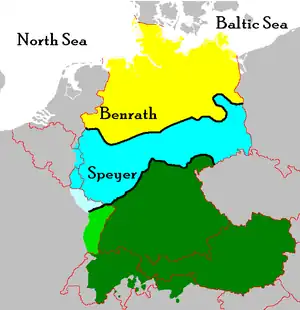同言線
同言線 (isogloss、heterogloss),也稱作等語線 ,是指某一個特定的語言學特徵的分佈地理界線 ,譬如,某個元音的發音、某個詞彙的意義、或是某種句法。方言界線的劃分一般就是許多條大致重疊的同言線 。

法罗群岛同言線
詞源
同言線英語「isogloss」源自古希臘文 ísos 「相同、近似」和 glōssa 「舌頭、方言、語言」,其靈感源自於等高線或等壓線。雖然如此,同言線的意義並非將講相同語言的地區以線連接起來,反而是為了分隔講不同方言的地區。因此,「同言線」此名曾被建議改名為「異言線」(heterogloss,其hetero源自ἕτερος héteros 「另外、相異」)[1]。
例子
參考資料
- Sihler, Andrew L. . Current issues in linguistic theory 191. Amsterdam/Philadelphia: John Benjamins Publishing. 2000: 170. ISBN 90-272-3698-4.
- Fortson IV, Benjamin W. . Blackwell Publishing. 2004: 52–54. ISBN 1-4051-0316-7.
- Rix, Helmut. . Dr. Ludwig Reichert Verlag. 2001: 359. ISBN 3-89500-219-4.
參考文獻
- Chambers, J.K.; Trudgill, Peter. . Cambridge Textbooks in Linguistics 2nd. Cambridge University Press. 28 December 1998. ISBN 0-521-59646-7.
- Woodard, Roger D. . New York: Cambridge University Press. 31 May 2004. ISBN 0-521-56256-2.
外部連結
- 江苏境内长江两岸江淮官话与吴语边界的同言线
- An example of an isogloss in Southern England.
- Beyond the Isogloss: The Isograph in Dialect Topography: A discussion of the shortcomings and oversimplifications of using isoglosses.
- On Some Acoustic Correlates of Isoglossy (页面存档备份,存于): A humorous analysis of Russian isoglossy.
This article is issued from Wikipedia. The text is licensed under Creative Commons - Attribution - Sharealike. Additional terms may apply for the media files.
